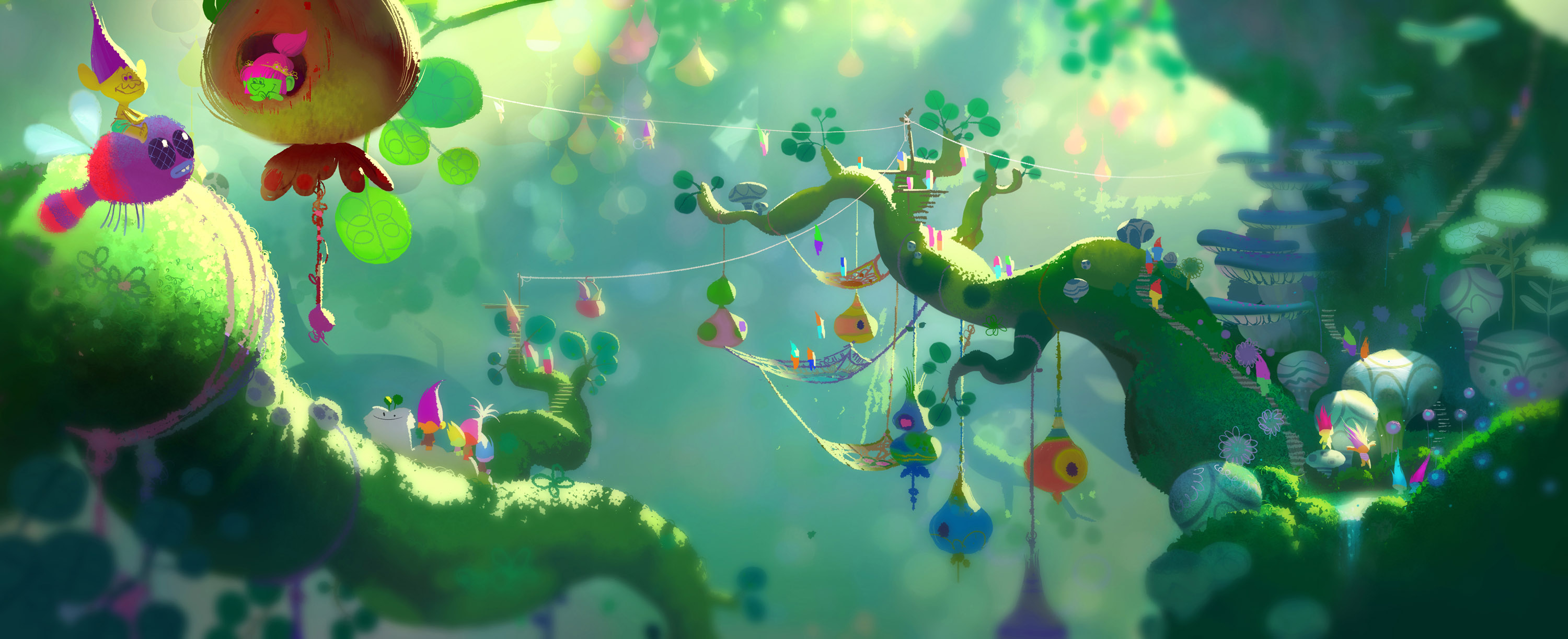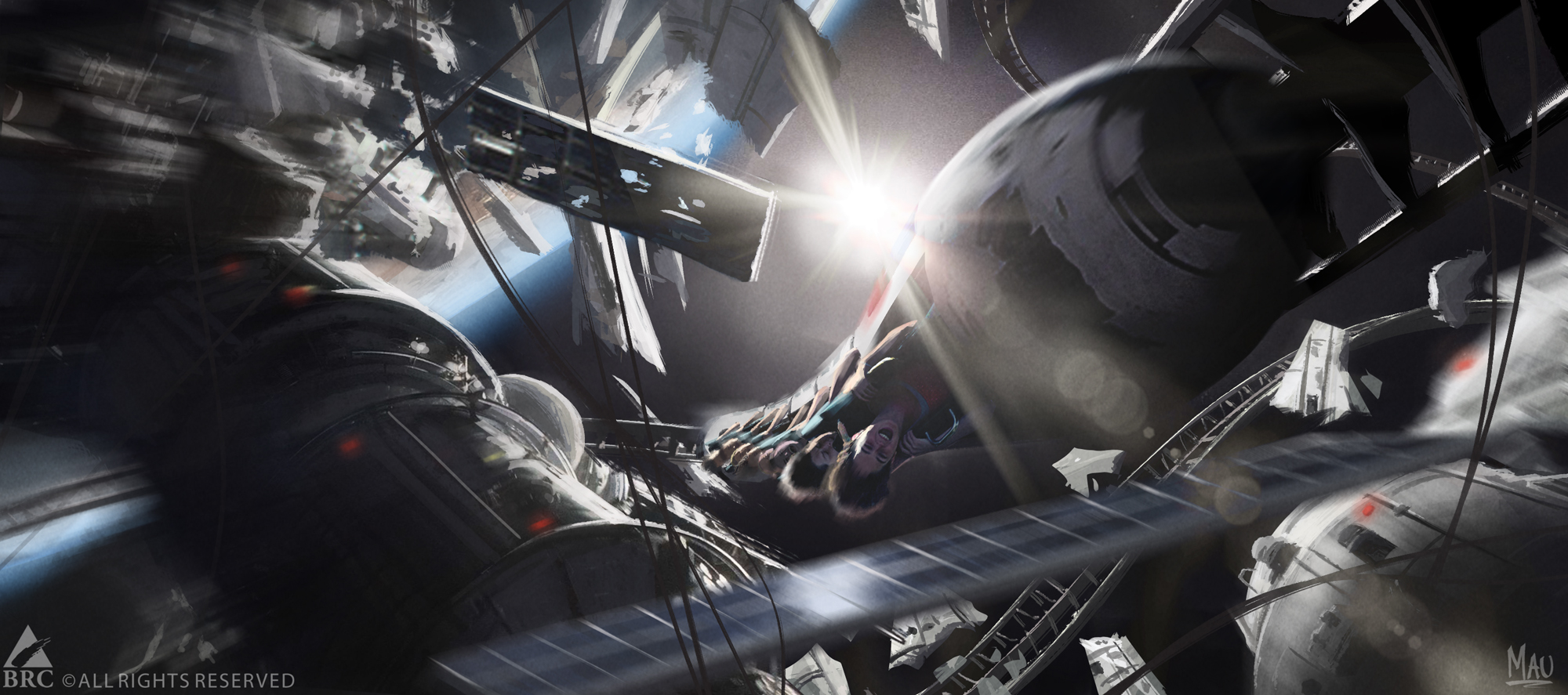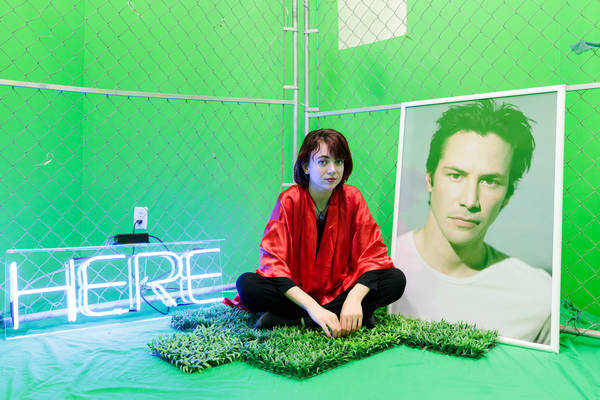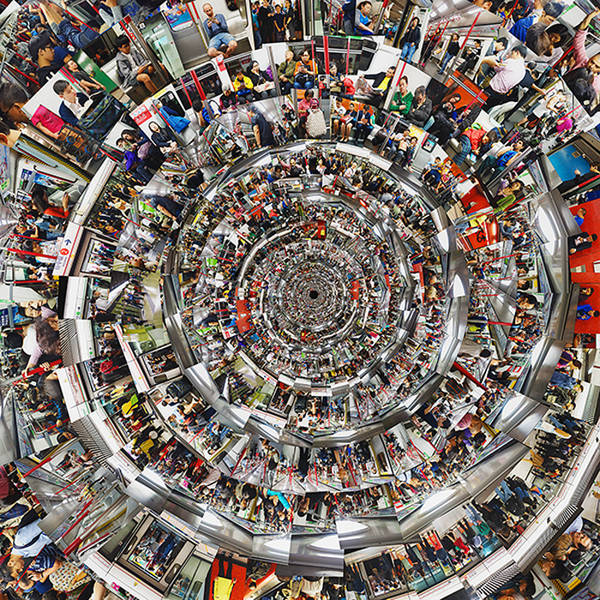feature / alumni / faculty / students / entertainment-design / internships
May 12, 2017
Writer: Solvej Schou
THE JOYS OF WORLD BUILDING: ENTERTAINMENT DESIGN SHINES
Work long, and work hard. That’s the mantra recent Entertainment Design alumna and Los Angeles native Michelle Rhee (BS 2016) grew up with.
New Entertainment Design Chair Guillaume Aretos—an award-winning animation and film art director and production designer whose credits include DreamWorks’ hit Shrek franchise, Puss In Boots and Edko Films’ upcoming sequel to Chinese blockbuster Monster Hunt—introduced a more well-rounded mantra when he swept into Rhee’s Entertainment Senior Project class one day last November.
In a rush, Aretos stopped, breathed in and took time to sit down with Rhee and the course’s 13 other students as not just their instructor, but as someone with 25 years of jam-packed experience. In French-inflected English, Paris-born-and-raised Aretos—his brown hair an electric mass—unleashed wisdom about the importance of work-life balance after they graduate.
“It was a heart-to-heart, intimate conversation,” said aspiring animation production designer Rhee, remembering Aretos’ fatherly advice. “He said it’s great to work hard, but don’t lose yourself in work, and don’t forget yourself, no matter what company you’re at.”

The skills you need to be professional in your job is not just your ability to draw and paint. It’s also your ability to work with others.
Entertainment Design Chair Guillaume Aretos

Aretos joined ArtCenter in Spring 2016, following concept artist and former Entertainment Design Chair Tim Flattery. The department, which launched in Fall 2005, houses two curriculum tracks. Concept Design focuses on the creativity and skills—drawing, painting, conceptualizing an idea—needed to be a concept artist, whether for films, video games or virtual reality (VR). Character Animation emphasizes designing, modeling and bringing to life dazzling characters through digital 3D and 2D animation. Students take classes such as Viscom Fundamentals, which focuses on visual communication and clearly illustrating design concepts.
“The program prepares students for designing worlds and telling stories visually, and it’s the best I know of to do that,” said Aretos recently, sipping coffee inside his office in an airy and newly renovated portion of Hillside Campus; the walls decorated with vast landscapes created by students.
Entertainment Design alumni go on to jobs with companies such as Disney, Pixar, Riot Games, Sony and DreamWorks, and work in animation, video games, theme park design, film and television—fields where ArtCenter alumni from majors such as Illustration, which has an Entertainment Arts track, have also flourished.
“Our close relationship allows students from each major to work alongside each other as they will in their professions,” said Illustration Chair Ann Field.
In addition to a successful design career, Aretos—who started out as a “very shy kid,” he said—started professionally acting when he was 14, played the lead in the ‘80s French TV version of Three’s Company, and has voiced characters in animated feature films, including the Shrek movies. He graduated from L’ Ecole Superieure des Beaux Arts de Paris and also studied industrial and product design at L’ Ecole Nationale Superieure de Creation Industrielle. He’s directed plays, written scripts and authored books. He once even owned a farm, with horses, in France.
WORK BY RECENT ENTERTAINMENT DESIGN ALUMNI (CLICK IMAGE TO VIEW GALLERY):
Aretos moved to California in the mid-‘90s, when DreamWorks brought him in as a concept artist on 1998’s Antz, the studio’s first animated feature film, based on an illustrated book he did on the tiny insects. Last year, he started the studio Alpha Animation with some animation veterans.
“I want to continue the College’s tradition of craftsmanship and almost industrial design thinking about character design and prop design, and also push storytelling and working in teams,” said Aretos, who noted that the timeline for a game, an animated movie or a theme park—all collaborative efforts—is about three years.
Whether the team is six people or a huge team of 300 people, the human skills you need to be efficient and professional in your job is not just your ability to draw and paint,” he added. “It’s also your ability to work with others.”
Aretos aims to propel the department forward by pairing students together to make a short animated film so they “don’t animate characters in a vacuum,” but tell stories within a setting. The gang behind the 2001 animated green monster fable Shrek, which Aretos art directed, before becoming production designer on Shrek 2 and Shrek 3, was “like a family,” he said.

A production designer is responsible for designing the look of the film, and I feel like I’m good at finding something unique for a story.
Alumna Kendal Cronkhite

His longtime DreamWorks colleague and friend Kendal Cronkhite (BFA 87 Illustration) knows first-hand what it’s like to take an animated feature from an initial idea and sketch to the glorious big screen, with a group of artists.
“I used to always say, ‘I love to make my films right after Guillaume’ because he’s trained that crew so well that they’re at the top of their game when they come onto my film,” she said.
The Bay Area-based production designer of movies including 2016’s brightly colored and ‘70s Scandinavian influenced Trolls, Cronkhite came to ArtCenter from Canada in her early 20s.
“Being at ArtCenter was a highlight of my life, honestly, and they cared so much about grounding us in strong skills,” she said, misty-eyed, on a break at her Glendale DreamWorks office, next to a board of green and blue yarn resembling toy troll hair.

After graduating, Cronkhite channeled a love of editorial illustration, punk, Picasso and other artists into animation, and first joined DreamWorks on Antz.
“A production designer is responsible for designing the look of the film, and I feel like I’m good at finding something unique for a particular story and not necessarily basing it on what I’ve done before,” said Cronkhite.
Cronkhite was previously also a consultant for Oculus VR’s newly shuttered Oculus Story Studio, where she was working on a project, she said, that took “huge steps forward in virtual reality,” a fast-growing form of storytelling.
“Being a concept artist—the most classic, realistic job Entertainment Design prepares you for—can be applied to film, games, theme parks, augmented reality, virtual reality or any new medium,” said Aretos. “At first, it’s ‘blue sky’ thinking, having fun imagining whatever you want to do, and then stuff starts to gel. The production phase of your job is designing every prop, every surface and every detail of every set.”
My versatility has helped my career. What I do spans from rough line sketches to finished color paintings.
Alum Mauricio Abril

Pasadena-based alum Mauricio Abril (BS 11 Entertainment) applied his degree towards becoming a freelance concept artist in animation, video games, theme park design and illustration. His clients have included Disney Interactive, Universal Creative, Ubisoft and Hasbro.
He also has an undergraduate degree in—of all things—molecular biology.
“Scientists approach solving a problem in a creative way, and entertainment design is essentially the same,” he said. “It’s analytical.”
A year after graduating, he did concept sketches for a splashy canoe ride at a new Disney theme park in Shanghai—thrilling since he grew up going to Disneyland.
For an online 2014 promotional campaign for video game Assassin’s Creed Unity, he created illustrations visualizing revolutionary France. He’s created concept art for a swerving space-themed roller coaster for a proposed entertainment center in Philadelphia.
A Simon and Schuster book he co-illustrated, Robots Can't Dance … and Other Fun Facts, comes out in August.
“My versatility has helped my career so far,” said Abril. “What I do spans from rough line sketches to finished color paintings. If the client needs something cute and colorful, I can do that, or something more realistic and gritty.”
At this point now, games and movies are sharing the same 3D technology.
Alumna Francesa Castellanos

Gritty and photorealistic could describe the more than a dozen video games that Austin-based game environment designer Francesa Castellanos (BS 97 Transportation) has worked on within her 20-year career.
Castellanos intended to go into car design after graduating from ArtCenter, but instead went into game design because of burgeoning opportunities in the field.
She has contributed to 2013’s Lost Planet 3 and 2016 first-person shooter games Doom and Call of Duty: Modern Warfare Remastered. She most enjoys working on tactical military first person shooter games, where winning is based on reflexes and decision-making, like a fluid, shrewd game of checkers.
Video game quality, she notes, has skyrocketed since she first started as a concept artist in the field.
“At this point now, we’re close to movie quality, and games and movies are sharing the same 3D technology,” Castellanos said. “As games get more realistic, we’re specializing. Before, I would do everything. Now I mainly world build, and build out other people’s designs.”
She’s also adept at focusing on details that make a big difference.
For example, with Call of Duty: Modern Warfare Remastered, Castellanos concentrated on lighting, including touches like adding a lower back light in a room to show off a chair’s design by a colleague.
“The process of designing a game or a film is extremely psychological, and everything is at the service of the story, from the lighting to the characters,” said Aretos. “Being able to draw, paint and model any world in 3D makes you a fabulous addition to any team.”
You’re not always going to be the best one in the room, so you have to up your craft, and that’s valuable.
Alum Craig Shoji

For Craig Shoji, who studied Entertainment Design when the program first began, not having a hotshot attitude has helped him navigate through that psychological—and at times high stakes—design process.
The Oakland-based freelancer has designed and illustrated concept art for a long list of big budget blockbuster films, including 2015’s Jurassic World, 2014’s Maleficent and 2011’s Thor.
“When you work in an art department, you’re expected to produce right out of the gate. It’s crazy and chaotic,” he said. “But if you love film, and you love the product, you do it over and over again. Plus, you’re not always going to be the best one in the room, so you have to up your craft, and that’s humbling and valuable in the professional world.”
Shoji, a big movie and comic book fan as a kid, first landed an internship, and then a job, on 2009’s Oscar-winning science fiction smash Avatar through Entertainment Design’s founding Chair Scott Robertson, and designed alien plants and props for the film.
That experience jumpstarted his career.
“On Jurassic World, the director, production designer and supervising art director would come watch me flying around navigating an environment I designed in 3D program Modo, which was a little nerve-wracking at first,” he said. “Since I could hand the set designers assets in 3D, parts of the movie ended up looking very close to my actual designs. I said, ‘Oh my god, that’s what I did!’ That’s an awesome feeling.”
For Aretos, an awesome feeling—the opposite of fear—is vital for students venturing out into the competitive realm of entertainment.
“When I became art director on Shrek, I was terrified of not being able to do the job,” he said. “That’s why I’m teaching students as early as I can so that they don’t get into that same frame of mind. I want students to feel ready, and confident. There’s nothing more joyful than having collaborators who are bringing crazy ideas, brainstorming and coming with you on that adventure.”



















